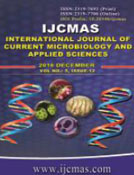


 National Academy of Agricultural Sciences (NAAS)
National Academy of Agricultural Sciences (NAAS)

|
PRINT ISSN : 2319-7692
Online ISSN : 2319-7706 Issues : 12 per year Publisher : Excellent Publishers Email : editorijcmas@gmail.com / submit@ijcmas.com Editor-in-chief: Dr.M.Prakash Index Copernicus ICV 2018: 95.39 NAAS RATING 2020: 5.38 |
Neisseria gonorrhoeae is becoming resistant to most of the antimicrobials used to treat gonorrhea, leading to an increasing number of treatment failures worldwide. The aim of this study was to assess its current antimicrobial resistance trends in Cameroon. Surveillance of N. gonorrhoeae antimicrobial resistance was performed from 2008 to 2015 (before and after the launching of Gonococcal Antimicrobial Surveillance Program (GASP)) in Cameroon, using E-tests and disk diffusion assay. β-lactamase production was detected using nitrocefin discs. Resistance rates over the years were statistically compared for significance using the X² test; the two-sided P-values of <0.05 were considered statistically significant. A total of 294 gonococcal strains were isolated, with up to 6.9% isolates with decreased susceptibility to ceftriaxone were registered in 2013. Rapid and dramatic change was noticed in ciprofloxacin resistance getting from 9% (2012) to 54% (2015). 26% of all isolates showed simultaneous resistance to penicillin G, tetracycline and ciprofloxacin. In 2015, 02 isolates resistant to 7 out of 8 antimicrobials tested, including ceftriaxone and ciprofloxacin (currently recommended for gonorrhea treatment in Cameroon) were detected, susceptible only to cefixim which is not available in Cameroonian hospitals. These results highlight the urgent need to revise gonorrhea treatment guidelines in Cameroon.
 |
 |
 |
 |
 |